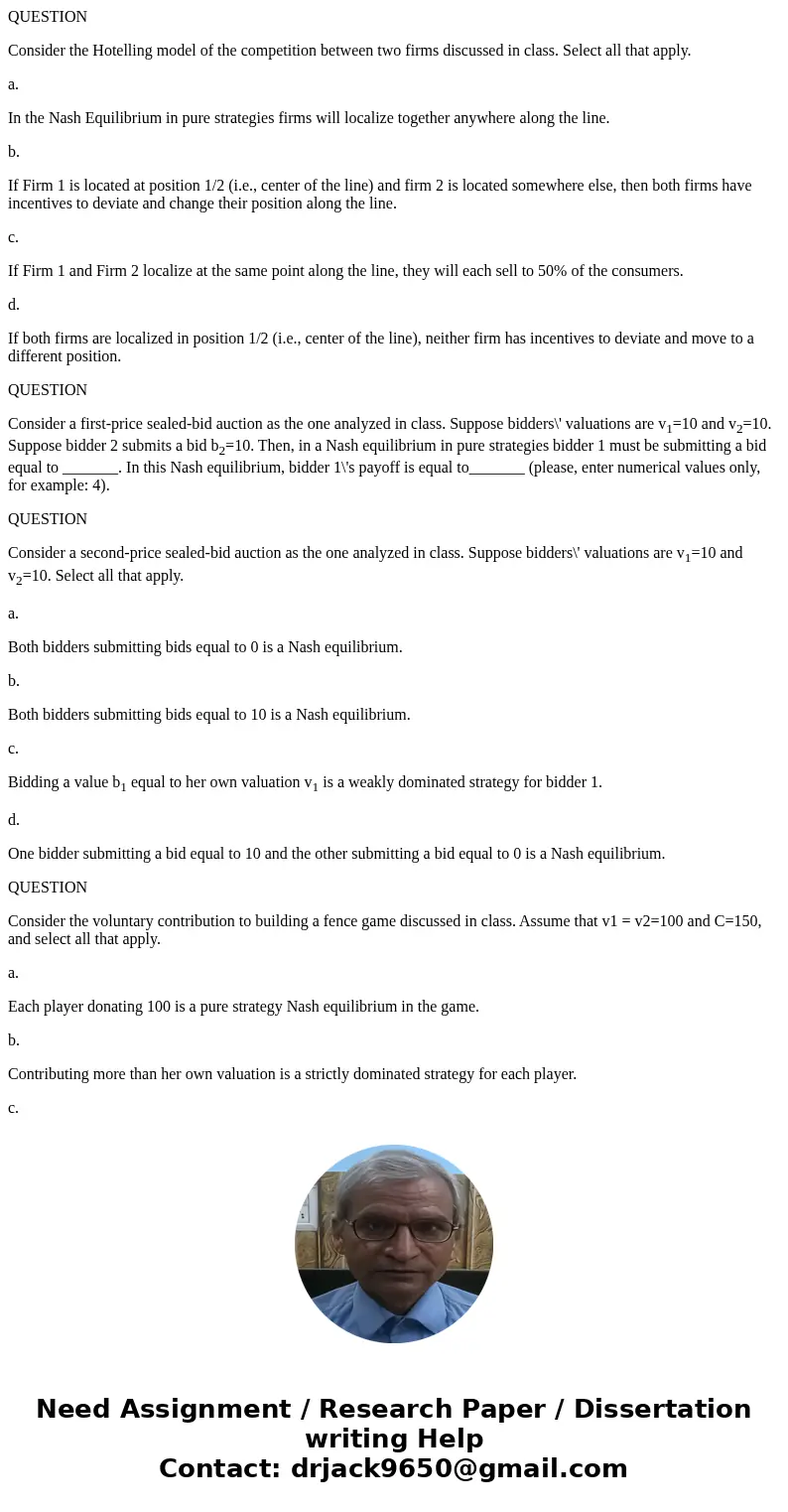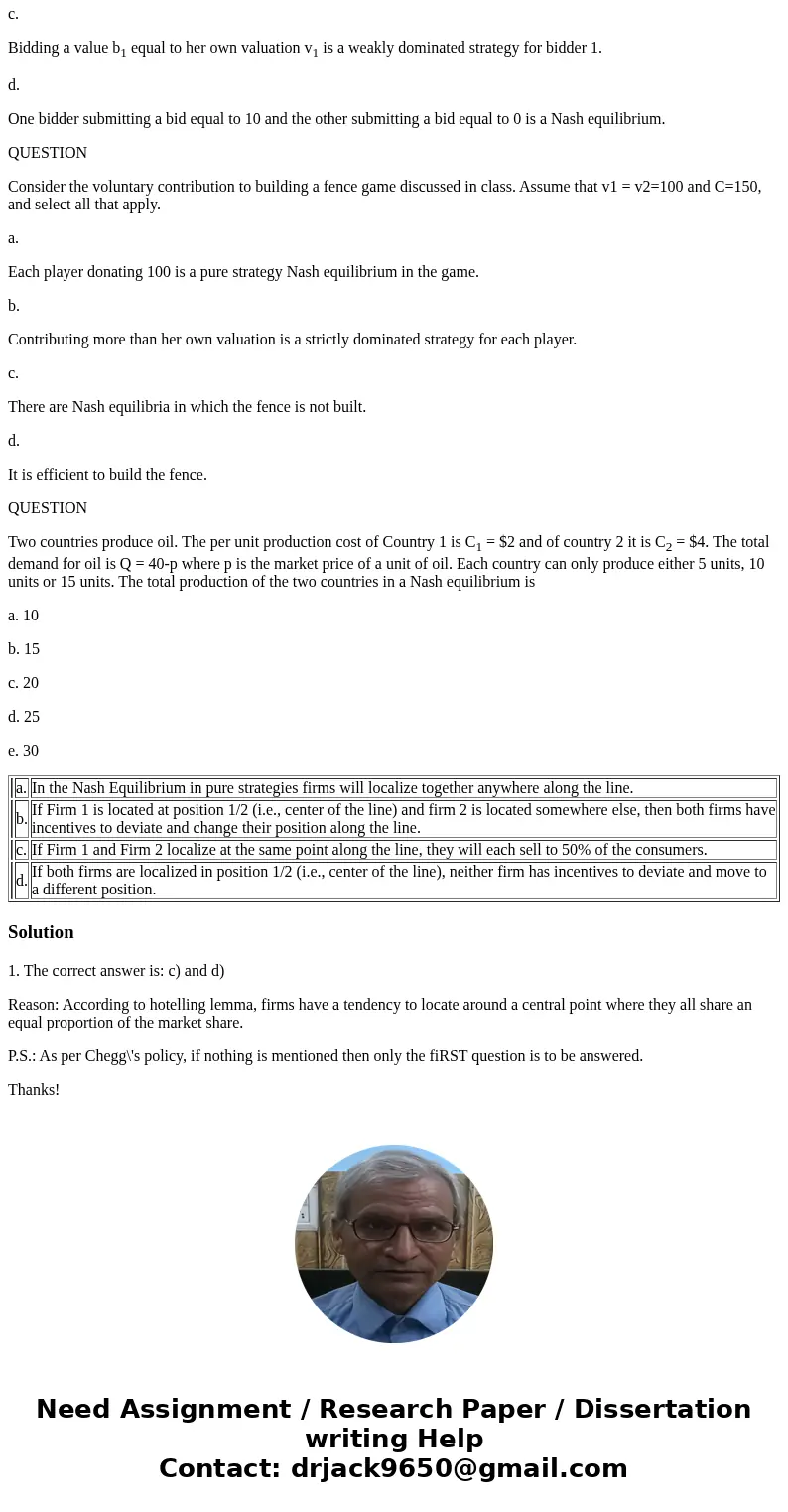QUESTION Consider the Hotelling model of the competition bet
QUESTION
Consider the Hotelling model of the competition between two firms discussed in class. Select all that apply.
a.
In the Nash Equilibrium in pure strategies firms will localize together anywhere along the line.
b.
If Firm 1 is located at position 1/2 (i.e., center of the line) and firm 2 is located somewhere else, then both firms have incentives to deviate and change their position along the line.
c.
If Firm 1 and Firm 2 localize at the same point along the line, they will each sell to 50% of the consumers.
d.
If both firms are localized in position 1/2 (i.e., center of the line), neither firm has incentives to deviate and move to a different position.
QUESTION
Consider a first-price sealed-bid auction as the one analyzed in class. Suppose bidders\' valuations are v1=10 and v2=10. Suppose bidder 2 submits a bid b2=10. Then, in a Nash equilibrium in pure strategies bidder 1 must be submitting a bid equal to _______. In this Nash equilibrium, bidder 1\'s payoff is equal to_______ (please, enter numerical values only, for example: 4).
QUESTION
Consider a second-price sealed-bid auction as the one analyzed in class. Suppose bidders\' valuations are v1=10 and v2=10. Select all that apply.
a.
Both bidders submitting bids equal to 0 is a Nash equilibrium.
b.
Both bidders submitting bids equal to 10 is a Nash equilibrium.
c.
Bidding a value b1 equal to her own valuation v1 is a weakly dominated strategy for bidder 1.
d.
One bidder submitting a bid equal to 10 and the other submitting a bid equal to 0 is a Nash equilibrium.
QUESTION
Consider the voluntary contribution to building a fence game discussed in class. Assume that v1 = v2=100 and C=150, and select all that apply.
a.
Each player donating 100 is a pure strategy Nash equilibrium in the game.
b.
Contributing more than her own valuation is a strictly dominated strategy for each player.
c.
There are Nash equilibria in which the fence is not built.
d.
It is efficient to build the fence.
QUESTION
Two countries produce oil. The per unit production cost of Country 1 is C1 = $2 and of country 2 it is C2 = $4. The total demand for oil is Q = 40-p where p is the market price of a unit of oil. Each country can only produce either 5 units, 10 units or 15 units. The total production of the two countries in a Nash equilibrium is
a. 10
b. 15
c. 20
d. 25
e. 30
| a. | In the Nash Equilibrium in pure strategies firms will localize together anywhere along the line. | |
| b. | If Firm 1 is located at position 1/2 (i.e., center of the line) and firm 2 is located somewhere else, then both firms have incentives to deviate and change their position along the line. | |
| c. | If Firm 1 and Firm 2 localize at the same point along the line, they will each sell to 50% of the consumers. | |
| d. | If both firms are localized in position 1/2 (i.e., center of the line), neither firm has incentives to deviate and move to a different position. |
Solution
1. The correct answer is: c) and d)
Reason: According to hotelling lemma, firms have a tendency to locate around a central point where they all share an equal proportion of the market share.
P.S.: As per Chegg\'s policy, if nothing is mentioned then only the fiRST question is to be answered.
Thanks!


 Homework Sourse
Homework Sourse